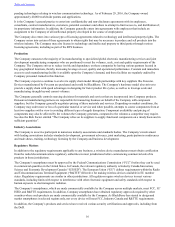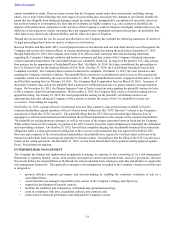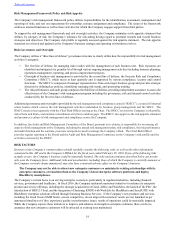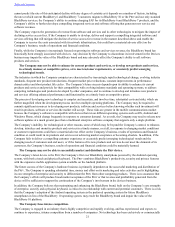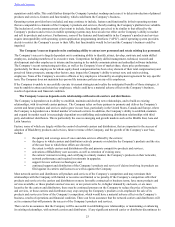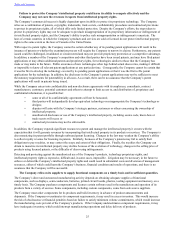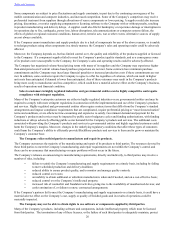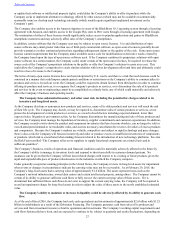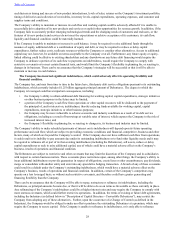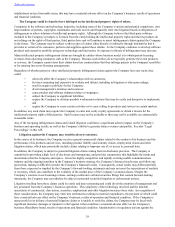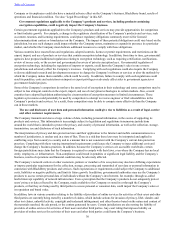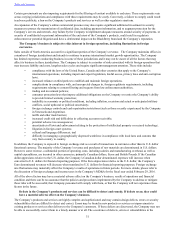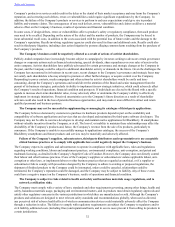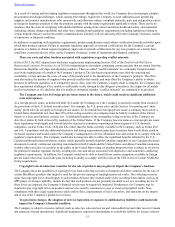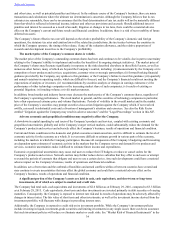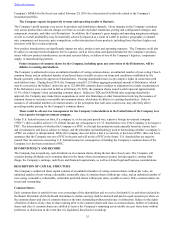Blackberry 2016 Annual Report Download - page 34
Download and view the complete annual report
Please find page 34 of the 2016 Blackberry annual report below. You can navigate through the pages in the report by either clicking on the pages listed below, or by using the keyword search tool below to find specific information within the annual report.
Table of Contents
25
Failure to protect the Company’s intellectual property could harm its ability to compete effectively and the
Company may not earn the revenues it expects from intellectual property rights.
The Company’s commercial success is highly dependent upon its ability to protect its proprietary technology. The Company
relies on a combination of patents, copyrights, trademarks, trade secrets, confidentiality procedures and contractual provisions
to protect its proprietary rights, all of which offer only limited protection. Despite the Company’s efforts, the steps taken to
protect its proprietary rights may not be adequate to preclude misappropriation of its proprietary information or infringement of
its intellectual property rights, and the Company’s ability to police such misappropriation or infringement is uncertain. The
laws of certain countries in which the Company’s products and services are sold or licensed do not protect intellectual property
rights to the same extent as the laws of Canada or the United States.
With respect to patent rights, the Company cannot be certain whether any of its pending patent applications will result in the
issuance of patents or whether the examination process will require the Company to narrow its claims. Furthermore, any patents
issued could be challenged, invalidated or circumvented and may not provide proprietary protection or a competitive advantage.
In addition, a number of the Company’s competitors and other third parties have been issued patents, and may have filed patent
applications or may obtain additional patents and proprietary rights, for technologies similar to those that the Company has
made or may make in the future. Public awareness of new technologies often lags behind actual discoveries, making it difficult
or impossible to know all relevant patent applications at any particular time. Consequently, the Company cannot be certain that
it was the first to develop the technology covered by its pending patent applications or that it was the first to file patent
applications for the technology. In addition, the disclosure in the Company’s patent applications may not be sufficient to meet
the statutory requirements for patentability in all cases. As a result, there can be no assurance that the Company’s patent
applications will result in patents being issued.
While the Company enters into confidentiality and non-disclosure agreements with its employees, consultants, contract
manufacturers, customers, potential customers and others to attempt to limit access to, and distribution of, proprietary and
confidential information, it is possible that:
• some or all of its confidentiality agreements will not be honoured;
• third parties will independently develop equivalent technology or misappropriate the Company’s technology or
designs;
• disputes will arise with the Company’s strategic partners, customers or others concerning the ownership of
intellectual property;
• unauthorized disclosure or use of the Company’s intellectual property, including source code, know-how or
trade secrets will occur; or
• contractual provisions may not be enforceable.
In addition, the Company expends significant resources to patent and manage the intellectual property it creates with the
expectation that it will generate revenues by incorporating that intellectual property in its products or services. The Company is
also monetizing its patent portfolio through outbound patent licensing. Changes in the law may weaken the Company’s ability
to collect royalty revenue for licensing its patents. Similarly, licensees of the Company’s patents may fail to satisfy their
obligations to pay royalties, or may contest the scope and extent of their obligations. Finally, the royalties the Company can
obtain to monetize its intellectual property may decline because of the evolution of technology, changes in the selling price of
products using licensed patents, or the difficulty of discovering infringements.
Detecting and protecting against the unauthorized use of the Company’s products, technology proprietary rights, and
intellectual property rights is expensive, difficult and, in some cases, impossible. Litigation may be necessary in the future to
enforce or defend the Company’s intellectual property rights and could result in substantial costs and diversion of management
resources, either of which could harm the Company’s business, financial condition and results of operations, and there is no
assurance that the Company will be successful.
The Company relies on its suppliers to supply functional components on a timely basis and in sufficient quantities.
The Company’s direct and outsourced manufacturing activity depends on obtaining adequate supplies of functional
components, such as displays, semi-conductors, batteries, printed circuit boards, plastics, tooling equipment and memory, on a
timely basis. The Company purchases components and licenses certain software used in the manufacture and operation of its
products from a variety of sources. Some components, including custom components, come from sole source suppliers.
The Company must order components for its products and build inventory in advance of product announcements and
shipments. If the Company overestimates its component requirements, it may result in excess inventory. This would increase
the risk of obsolescence or financial penalties based on failure to satisfy minimum volume commitments, which would increase
the manufacturing costs per unit of the Company’s products. If the Company underestimates component requirements, it may
have inadequate inventory, which could interrupt manufacturing operations and delay delivery of products.



